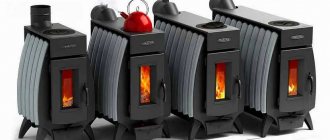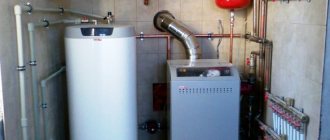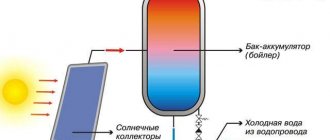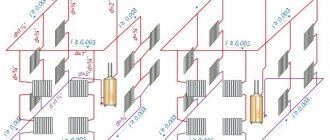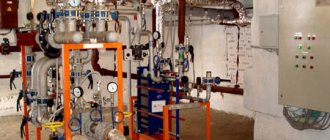The use of “green” energy supplied by natural elements can significantly reduce utility costs. For example, by arranging solar heating for a private home, you will supply low-temperature radiators and underfloor heating systems with virtually free coolant. Agree, this is already saving money.
You will learn everything about “green technologies” from our proposed article. With our help, you can easily understand the types of solar installations, the methods of their construction and the specifics of operation. You will probably be interested in one of the popular options that are actively working in the world, but are not yet in great demand here.
In the review presented to your attention, the design features of the systems are analyzed and the connection diagrams are described in detail. An example of calculating a solar heating circuit is given to assess the realities of its construction. To help independent craftsmen, photo collections and videos are included.
Solar heating
The essence of the process comes down to absorbing the thermal energy of the sun and transferring it to the coolant, which, in turn, must be transferred to the heating system of the house and transfer the heat to the air in the rooms. Considering how hot water left in an open container at midday heats up, the process does not represent anything supernatural.
Unfortunately, such a system will be most effective during the period of maximum activity of the star, that is, during the period from May to August, when the sunny day has the longest duration and the least amount of precipitation falls. In the winter-autumn period, when the need for heating arises, the picture looks different.
A short sunny day already limits the life of a solar device. On cloudy days, it will not be possible to use either the collector or the battery. Therefore, it is not possible to use solar heating as the main one. However, as an alternative source of heat in winter and hot water in summer, the system is quite effective.
Tips for use
- The operation of a solar heating system is carried out in accordance with the design of the collectors, their number and other features.
- The main task for the owner is to maintain cleanliness and timely removal of dust and other contaminants . This allows for maximum thermal energy intake and increases the efficiency of the entire system as a whole.
- It is necessary to properly insulate all connecting pipelines and storage tanks , excluding heat loss.
- It is recommended to always keep one or two panels in reserve so that in case of mechanical damage you can quickly replace them. Following these simple recommendations will increase the efficiency of the system and ensure comfort and coziness in the home.
Advantages and disadvantages of solar heating
Solar heaters for any type of home have the following advantages:
- system autonomy - you will no longer depend on utility services and their prices;
- despite the high price of the equipment, the total operating cost will decrease every year;
- noiselessness;
- long service life;
- environmental safety of the generated energy;
- operation in various climatic conditions: wind, rain, snow;
- the ability to accumulate received energy.
Flaws:
- The efficiency of use decreases sharply when the photocells become very hot, so it is advisable to install additional cooling systems.
- The outer surface of the panels must be regularly cleaned of dirt and dust.
- Presence of toxic substances in photocells. During operation, they do not in any way affect the purity of the energy released, but require safe disposal.
- After 25–30 years of active use, the performance of panels drops by at least 10%.
- The efficiency of batteries directly depends on weather conditions, so they need to be equipped with additional energy storage systems.
Options for self-assembly of the heating system
Today, there are several ways to assemble a solar heater with your own hands. Let's look at the most popular assembly methods. First option. Here you need a galvanized container for water. It should have a volume of approximately 100-200 liters. The technology for creating a solar battery has the following algorithm:
- We place the container on the roof. It should be installed on the south side of the roof;
- the roof surface must be covered with a metal sheet with a shiny surface;
- put pipes on top of it;
- we connect them to a barrel and a container for heated water.
Homemade solar collector option
With the help of such a battery, 100 liters of water can be heated by 60 degrees. This installation has high efficiency. But in winter, such a unit will not be effective. Second assembly option. To create this type of collector you will need:
- steel boxes;
- several flat steel radiators;
- glass;
- metal-plastic elements - fittings and pipes.
The system builds in this case proceed as follows:
- steel boxes are mounted on the roof;
- radiators are placed there;
- Cover them with glass on top. This will reduce the water heating time;
- the tubes must be laid with a downward slope;
- be sure to ensure that the top of the device is located below the storage tank;
- A plastic barrel with water is installed in the attic. Suitable volume - 160 l;
- it must be connected to the radiator and water supply using metal-plastic devices - fittings and tubes. The water tube itself needs to be connected slightly above the middle of the tank;
- Drain valves are installed at the bottom of the radiator. With their help, water is drained during the cold season.
Option with plastic barrel
Third option. It is used to heat a fairly large room. Has an efficiency of 45-55%. To create this type of heating system you will need the following materials:
- any thermal insulation material;
- wooden frame with a plywood bottom;
- black metal mesh;
- deflector;
- transparent polycarbonate sheet;
- several fans
Principle of operation
The operating principle of solar panels is to generate electrical energy; they do not accumulate or generate it in any way. When the sun's rays directly hit their surface, they are immediately converted into current and removed from the panel.
Each plate can produce 250 W, so to improve the principle of operation they try to install them closer to each other. The current obtained as a result of photosynthesis flows through the distributor into the batteries, and then into the inverter of the power grid at home.
It should be noted that the volume of solar batteries affects the duration of daily operation of the batteries. The batteries are recharged throughout the day while the energy generated the previous day is used.
The operating principle is simple and at the same time effective thanks to the “semiconductor”. A semiconductor contains atoms that, thanks to an external electron, can capture or reflect other electrons. As a result, the surface of the solar cells is covered with this material. This “semiconductor” is Selenium and Silicon.
Tubular manifolds
Here, too, the coolant circulates through pipes, but each of these heat exchange pipes is inserted into a glass flask. They are all connected in a manifold, which is essentially a comb.
Diagram of a tubular collector (click to enlarge the picture)
Tubular collectors have two types of tubes: coaxial and feather. Coaxial - a pipe in a pipe - nested one inside the other and their edges are sealed. A rarefied airless environment is created inside between the two walls. That is why such tubes are also called vacuum tubes. Feather tubes are just a regular tube sealed on one side. And they are called feather ones because, to increase heat transfer, an adsorber plate is inserted into them, which has curved edges and is somewhat reminiscent of a feather.
In addition, heat exchangers of different types can be inserted into different housings. The first are the Heat-pipe thermal channels. This is a whole system for converting sunlight into thermal energy. A heat-pipe is a small-diameter hollow copper tube sealed at one end. On the second there is a massive tip. A substance with a low boiling point is poured into the tube. When heated, the substance begins to boil, part of it turns into a gaseous state and rises up the tube. Along the way from the heated walls of the tube, it heats up more and more. It ends up in the upper part, where it stays for some time. During this time, the gas transfers part of the heat to the massive tip, gradually cools, condenses and settles down, where the process is repeated again.
Scheme of operation of the Heat-pipe thermal channel
The second method is U-type, which is a traditional tube filled with coolant. There's no news or surprises here. Everything is as usual: the coolant enters on one side, passes through the tube, and is heated by sunlight. Despite its simplicity, this type of heat exchanger is more effective. But it is used less often. And all because solar water heaters of this type form a single whole. If one tube is damaged, the entire section must be replaced.
Tubular collectors with a Heat-pipe system are more expensive, show lower efficiency, but are used more often. And all because a damaged tube can be changed in a couple of minutes. Moreover, if a coaxial flask is used, then the tube can also be repaired. It is simply disassembled (the top plug is removed) and the damaged element (thermal channel or the bulb itself) is replaced with a working one. The tube is then inserted into place.
Regular U-tube is the most efficient heat channel
Why are there no solar power plants on the roofs of our houses?
The Internet is replete with advertising materials with beautiful pictures telling about the extraordinary benefits of solar systems. Craftsmen post videos on YouTube on the topic “do-it-yourself solar heating” about their own know-how, assembled on their knees from scrap materials. The Internet is buzzing with reposts of enthusiastic articles about the wonderful benefits of solar heating. However, how many houses with solar collectors on the roof have appeared in recent years near your home? No one? What are the reasons that solar heating is not recognized in our area?
Unfortunately, solar energy for heating a home does not arrive when or where it is needed. It gets cold closer to the poles, in winter and at night. And the maximum solar radiation occurs in the equatorial regions, during the summer and during the day. At the very least, heat accumulators help smooth out daily, but not seasonal, differences.
Map of the intensity of distribution of sunlight across the territory of Russia. In the Western part of the country, where the lion's share of the population lives, there is little sun. And in eastern Siberia, where the share of radiation is noticeably higher, it is cold, which makes it difficult to use active systems. By the way, solar panels that generate electricity are not so sensitive to severe frosts. Quite powerful solar power plants have already been built and are successfully operating in cold but sunny Yakutia.
Passive heating with solar energy is ineffective and cannot significantly warm a house in Russian winter conditions. “Windows facing south” is a really useful design method that costs nothing, but helps optimize heating costs. But solar greenhouses, Trombe walls and their derivatives, once relatively popular in the United States, gradually faded away even in their homeland.
Active solar heating systems for a private home are very expensive; you will have to pay a lot of money for the equipment. Operation, contrary to some claims, is by no means free: electricity is consumed and equipment maintenance is required. At current prices, compared not only with cheap natural gas, but even with rather expensive pellets and diesel fuel, installing a vacuum solar collector in the vast majority of the territory of the Russian Federation will never pay off at all; the payback period exceeds the service life of the equipment. Only in some southern regions of the country can solar heating systems for a private home not be unprofitable under certain conditions.
Scientific station on Olkhon Island (Russia). The use of vacuum collectors (on the right on the roof) for preparing hot water and solar panels (on the left) for generating electricity makes sense, because there are no central communications on this rocky Baikal island. However, for proper heating in the climate of Buryatia, solar systems are not enough; the house is heated by “normal” stoves, the fuel for which is imported from the “mainland”, because it is impossible to destroy the local forest for firewood
What is a solar collector and its operating principle?
A solar thermal collector is a technical device that is capable of converting solar energy into heat. It is used to produce hot water, which can later be used for various needs. The main difference between solar collectors and other versions of similar equipment is the principle of changing the density of water during heating. Cold masses displace the heated water flow upward, so there is no need to use additional pumping equipment.
The operating principle of the device is as follows. Solar energy is absorbed in a receiving device, which can be copper or glass surfaces of dark or black color. Such materials are characterized by good energy absorption capacity.
Solar water heaters are conveniently located on the roof, where there is plenty of space and maximum sunlight. Here, such devices do not take up useful space and do not disturb anyone. Next, the heat from the storage tank is transferred to the coolant tank. This could be water, antifreeze or another liquid that is used in the heating system.
Operating principle of the solar collector
In most cases, a mixture of 40% glycol and 60% distilled water is used. The coolant, which is heated to a certain temperature, is supplied to the radiators through a piping system.
The direction of water movement in the system can change thanks to the mixer. Cooled and warm water constantly replace each other. This natural circulation occurs due to the expansion of warm water, which rises, displacing cold water into the heating tank.
This heating system must be equipped with a thermal insulation layer at least 25-30 cm thick, which will ensure its efficient and stable operation. It is better to use a rectangular tank as a storage tank for coolant. A backup heating element can be located here. It will automatically come into operation when weather conditions are created that are not conducive to heating the coolant to the required temperature.
A solar collector is a device for converting solar energy into thermal energy
System selection and installation
The first thing that is required when choosing a particular system is to carefully study its capabilities. It is imperative to calculate the area of the home, as well as the amount of heat required to heat it. The installation location is another significant point. Reviews suggest that it would be best to use the help of qualified specialists in this field. This is due to the fact that even with a slight miscalculation, the effectiveness of the finished solution during operation can be greatly reduced. If a solar battery for heating a house is installed correctly, it will last at least 25 years. Only 3 years are needed for its full payback. Many people do not consider this period too long, judging by the same user reviews
This allows you to become completely independent from utilities, and this is very important
The solar panel for heating the house should be installed so that the solar illumination in this place is maximum. If the selected building is not suitable for installing such a system, then you can use a neighboring building. The drive can easily be placed in the basement. There are also systems where several drives are used. In this case, their sizes will be a little more modest. Those who have decided to choose heating a private home with solar panels can confidently say that their decision was correct. Solar energy is an inexhaustible source of heat, and it is absolutely free. To do this, you only need to invest a certain amount in equipment and installation of the system, and then it will not only fully pay for itself, but will also eliminate the need to pay money to utility services.
15 Cancer Symptoms Women Most Often Ignore Many signs of cancer are similar to symptoms of other diseases or conditions, which is why they are often ignored.
Pay attention to your body. If you notice
Our ancestors slept differently than we do. What are we doing wrong? It’s hard to believe, but scientists and many historians are inclined to believe that modern man sleeps completely differently than his ancient ancestors. Initially.
How to look younger: the best haircuts for those over 30, 40, 50, 60 Girls in their 20s don’t worry about the shape and length of their hair. It seems that youth is created for experiments with appearance and daring curls. However, already last.
10 mysterious photographs that will shock Long before the advent of the Internet and the masters of Photoshop, the vast majority of photos taken were genuine. Sometimes the pictures captured were truly incredible.
What is it like to be a virgin at 30? I wonder what it’s like for women who didn’t have sex until almost middle age.
These 10 little things a man always notices in a woman Do you think your man doesn’t understand anything about female psychology? This is wrong. Not a single little thing can be hidden from the gaze of a partner who loves you. And here are 10 things.
Options for creating an air solar collector with your own hands
Making a traditional air solar collector for heating your home with your own hands begins with creating a frame from wooden boards. The back and end walls should be insulated with mineral wool. The housing is fixed to the wall. All gaps must be insulated with foam. On the sides there are holes for pipes for the entry and exit of air masses. External elements are securely wrapped with heat-insulating material.
A perforated metal sheet made of aluminum, which is characterized by high thermal conductivity and low cost, is used as an absorber. To increase selective qualities, it is coated with black paint. A sheet of glass or polycarbonate is placed on top.
Homemade air solar collector from corrugated pipe
The absorber can be made of rectangular water pipes, which are installed on an aluminum sheet and fixed to it using mounting tape and self-tapping screws. The back wall of the wooden case is insulated with mineral wool, and the side walls with expanded polystyrene. The pipes are painted black and covered with a sheet of tempered glass or polycarbonate.
An even simpler design is made from corrugated sheets. The frame is made of wooden blocks. An exit hole is made in the bottom. Corrugated sheeting with many holes throughout the entire area of the product is laid on the beam, which will ensure air flow.
A good solution is to build an air collector on the window. This is a fairly effective option that allows you to heat the room well. The frame is made of aluminum frames and attached to the window in the form of a mosquito net. The rear wall is made of aluminum sheet, in which holes are made in the lower (for intake of cold air) and in the upper (for removal of warm air) parts. The role of an absorber can also be performed by black foil, which is covered with a protective PVC film.
Are solar panels beneficial for a private home?
In Western countries, the fashion for solar energy is dictated more by concern for the environment than by the search for economic benefits. Our realities are somewhat different.
At current prices for supplied electricity, a solar panel system assembled with your own hands for one private home and a family of 4 people will fully pay for itself in 4-5 years. At the same time, the service life of photocells is 20-25 years, but the batteries will have to be changed after 5-7 years, depending on the quality of the batteries.
So far, nowhere in the world (and Russia is no exception) there has been a reduction in prices for supplied electricity, so over the life of the photocells in the solar panel, the system will have time to pay for itself at least 4-5 times.
Requirements for materials for the manufacture of a homemade solar collector
To make the frame of a solar collector for heating with your own hands, plywood, wooden beams, OSB boards or other similar options are used. As an alternative, you can use an aluminum or steel profile with inserts made of similar materials, which will give the structure strength and reliability. However, such a case will have a high cost.
Materials must meet the requirements for structures located outdoors. Since the average service life of a solar collector is 20-30 years, it is necessary that the materials have high performance characteristics that will remain unchanged throughout the entire service life of the installation.
Wood for the body must be treated with water-polymer compositions and coated with paint and varnish emulsions. The steel profile must be reliably protected from corrosion.
To make a solar collector with your own hands, the simplest materials are suitable.
To make a heliostat absorber with your own hands, you use available materials. The coil can be made from rigid PVC pipe with fittings, flexible HDPE pipe, bent copper or metal tube. The heat exchanger of an old refrigerator is suitable for the absorber. The element can also be made from aluminum cans or plastic bottles. The main selection criterion is the thermal conductivity of the material.
To prevent heat loss, the housing should be insulated on all sides. For these purposes, mineral wool or polystyrene foam is mainly used. The foil version of the insulation has proven itself well, which will provide not only thermal insulation, but also reflection of the sun's rays from the surface.
The heat exchanger is covered with a protective surface, which can be tempered glass or monolithic polycarbonate. The material should have a grooved rather than smooth surface.
Design of a heating system using collectors
First of all, we will take a closer look at the differences in the structure and functioning of batteries and collectors.
The panel consists of several photocells interconnected on a frame made of non-energy-conducting materials.
Photoelectric converters are quite complex structures, representing a kind of sandwich of plates with different characteristics and purposes.
In addition to solar modules and special fasteners, the system consists of the following elements:
- batteries for energy storage;
- a controller that will monitor the level of charge in the battery;
- inverter - to convert direct current into alternating current.
There are two types of collectors: vacuum and flat.
Vacuum collectors consist of hollow glass tubes containing smaller diameter tubes containing an energy absorber. Smaller tubes are connected to the coolant. In the free space between them there is a vacuum that retains heat.
The principle of operation of the solar collector
Flat-plate collectors consist of a frame and reinforced glass with a photoabsorbing layer. The absorber layer is connected to the coolant tubes.
Both of these systems consist of a heat exchange circuit and a heat accumulator (liquid tank).
From the tank, water enters the heating system using a pump. To avoid heat loss, the tank must be well insulated.
Such installations should be located on the southern slope of the roof. The tilt angle should be 30–45 degrees. If the location of the house or the roof structure does not allow installing solar system panels on the roof, then you can install them on special reinforced frames or on racks fixed to the wall.
The amount of solar energy released at different times of the year varies greatly. The insolation coefficient for your place of residence can be found on the solar activity map. Knowing the insolation coefficient, you can calculate the number of modules you need.
For example, you consume energy 8 kW/h, insolation is on average 2 kW/h. Solar panel power – 250 W (0.25 kW). Let's do the calculations: 8 / 2 / 0.25 = 16 pieces - this is exactly the number of panels you will need.
Where can I buy
A solar collector is a product that can only be purchased from specialized organizations and companies that either produce similar devices or are focused specifically on selling equipment that runs on alternative energy sources.
The most correct way to purchase is to find a dealer of the manufacturer of a specific device model, and then conclude an appropriate purchase and sale agreement with him. If there are no dealers of companies producing solar collectors in the region where the potential buyer lives, then you can find an organization that specializes in this group of products. These two purchase options are the most optimal, because... specialists from such companies can provide assistance in choosing a model and suggest how to perform installation.
If the above listed acquisition methods cannot be carried out, then you can turn to the Internet, where a fairly large number of companies operating specifically in this area of energy are represented. The advantage of this purchasing method will be the lower cost of the products, but the negative point is that there will be no advice or tips on choosing a model and its installation; you will have to decide everything yourself.
Active heating sunlight collected by vacuum collectors
Airborne solar collector
An airborne solar collector, equipped with a system of forced transmission and distribution of energy, is capable of producing much more heat compared to the passive option. The air circulation speed is automatically adjusted depending on the temperature in the house and the degree of heating of the collector. The air heated in the collectors can enter the ventilation system or room directly. If its temperature is high enough, it can also be used to heat the coolant liquid. Excess energy from the day is stored overnight in heat accumulators.
Solar air heating based on a solar collector. From the hollow panel (1) through the air channels (6), the fan drives air into the technical room, where automation, depending on the situation, distributes it to the air treatment unit (3) or a massive heat accumulator (2). At the same time, the hot water supply coil (5) can also heat up. During the day, when the rooms need heating, the system operates in mode B, warm air from the collector is directed to the rooms. When the required temperature in the house is reached, the air flow is redirected to the heat accumulator, mode A. At night, when the collector does not provide heat, the damper closes the channel leading to it, circulation is carried out between the heat accumulator and the rooms.
Vacuum solar collector
The most advanced solar heating device to date.
Schematic diagram of a vacuum solar collector. The liquid absorber circulating through the U-shaped tubes evaporates when heated and rises upward into the collector. The latter is connected to the circuit of the heating system and, in turn, coolant fluid circulates through it. The absorber releases energy to the coolant, cools, condenses, and falls down. The cycle repeats
Solar heating of a country house based on vacuum collectors is much more effective than other solar systems, however, in addition to the traditional uneven heat generation for solar systems, it has three more significant drawbacks: in severe frost, heat transfer drops sharply, the installations are fragile and expensive.
Vacuum solar collectors should be installed in such a way that they are protected from vandals. This is especially true for our country; getting a pebble into a glass tube is a nice thing
Vacuum panels are not connected directly to the heating system. At a minimum, buffer tanks are needed that will smooth out uneven heat generation.
The “correct” diagram for connecting a vacuum solar collector to a heating system. Heat is not transferred directly, but through a heat exchanger; excess heat during the day is stored at night in a heat accumulator (buffer tank)
Please note that the diagram shows a “normal” heating boiler; the solar system only complements it
Electric solar panels can only be used indirectly for heating. It is unwise to spend electricity directly on heating rooms; it can be used more rationally. For example, direct the operation of fans and automation of active solar systems.
Reviews
Thanks to the Internet, you can always find user reviews about various types of heating and the equipment used in its construction. Here are some of them:
- Alexander (Stavropol Territory):
“Two years ago I read an article about how you can save on heating costs by installing a solar collector. I found a company specializing in the sale of such products and entered into an agreement with them for the supply and installation of 3 collectors of the SCH-30 model. They installed and installed it quickly and I’ve been using it for the second season now. Of course, it took a lot of money, but the effect of use exceeded my expectations. I completely abandoned central heating and hot water supply, fortunately we have a lot of sun. Accordingly, utility bills have decreased, but the most important thing is that now I do not depend on heating networks and water utilities, since I previously dug my own well. I’m very pleased with the rational investment of my funds.”
- Konstantin (Lipetsk region):
“Many people argue whether the cost of purchasing equipment will pay off when installing an autonomous heating system based on solar collectors. There is no definite answer, but those who already use such devices say with confidence that this is beneficial, because skeptics do not take into account the fact that when connecting to external gas, heat and electricity networks, the organizations operating them ask for considerable sums when issuing technical specifications, as well as for the very fact of tapping into their communications. If we take into account that solar energy is an environmentally friendly sector of the economy, and the sun is an inexhaustible source of energy, then we can confidently say that green energy in general, and solar heating systems for housing, is the future.”
Features of solar heating installation
Solar heating is most effective in areas characterized by a large number of sunny days (especially during the winter).
Do-it-yourself solar (solar heating) home heating should be done taking into account the specific features of the installation:
Scheme of solar panels operation. Click to enlarge.
One of the most optimal options is combined heating of the house with gas (or electric) and solar energy.
This option, characterized by the integration of solar system elements into the existing heat supply scheme, can significantly increase heating efficiency and increase economic indicators.
When carrying out work in areas characterized by low levels of insolation (the flow of direct sunlight onto a horizontal surface), special attention must be paid to the optimal choice of collector area and the correct installation. When determining the level of insolation, it should be remembered that its intensity is higher in the middle of the day
In this regard, the collector planes should be oriented in a southerly direction. There may be some deviations in the southwest or southeast directions
When determining the level of insolation, it should be remembered that its intensity is higher in the middle of the day. In this regard, the collector planes should be oriented in a southerly direction. Some deviations in the southwest or southeast directions are possible.
When installing collectors, it is necessary to ensure that shadows from neighboring buildings or trees do not fall on them. Installing collectors at an angle equal to the geographic latitude of a given area can significantly increase their efficiency.
This is due to the fact that the maximum level of solar energy absorption occurs on collector surfaces located at right angles to the direction of insolation.
That is why it is necessary to increase the angle of inclination, which will increase the efficiency of the collector in winter, slightly increasing heat loss in summer. However, in summer, an increase in heat losses is quite acceptable due to an excess of thermal energy.
Advantages
The main advantage is that the Sun is a constant and inexhaustible source , stable and completely predictable. Unlike wind turbines, which can sit idle for weeks, solar energy is supplied at predetermined time intervals. The only drawback is the possibility of cloudy or cold weather, when the efficiency of the batteries and collectors decreases. However, modern designs make it possible to obtain a minimum amount even in the most difficult conditions, therefore, with correct calculation, no surprises threaten the heating system.
In addition, we must not forget that solar energy is obtained completely free of charge . If, when heating a house with gas or electric boilers, you need to purchase the equipment itself and then constantly pay for energy or fuel, then solar energy is not paid for, which significantly changes the level of profitability of the equipment and the entire system as a whole.
However, we should not forget that solar heating of a private house, the price and labor costs for installation of which often become the main problem, is beneficial only in regions with suitable climatic and weather conditions .
An additional advantage is the high maintainability of the system and the ability to increase its productivity . There are no restrictions in this matter - how many panels or collectors are installed, so much energy will be received. If the installed kit turns out to be incapable of effectively heating the house, it can always be strengthened by adding the required amount of equipment . This is convenient if you need to rebuild or expand the house, make an extension, etc. There is no need to buy a new system completely.
Heating a house with collector-type solar panels
At their core, collectors are really similar to solar panels, since they capture direct sunlight. An exception for the latter are thin-film plates that produce current from scattered light. As for collectors, flat models need hot solar radiation to heat water. The only option that actively supplies hot water to the pipes of the heating system all winter, even in dense clouds, is vacuum collectors
. It is the vacuum that saves precious heat.
If you decide to take the vacuum option, in this case you also have a choice - a direct or indirect water heating model. The former are considered seasonal, since the storage tank is located directly in the collector body, and tubes with a double shell, inside of which there is a vacuum environment, are directly connected to the tank. In winter, such models cannot be used, the water in them freezes.
Another thing is heating a house with solar panels of an all-season collector type. They will work even at -50 degrees and cloudy cover, since the storage tank is installed in the house. This system operates thanks to a coolant fluid moving through pipes between the spirals located inside the tank and the collector. The same liquid is poured into the cores of the vacuum tubes. The water is only in the storage tank; from it it flows through pipes into the batteries.
How to choose the best
In order to make the right choice and not make a mistake with the choice of the type of solar collector and its brand, you need to follow the selection criteria, which for such devices are:
- Possibility of using a solar system in the region where the equipment is to be installed;
- The power and performance of the device must correspond to the required values and usage indicators;
- The amount of heat loss - determines the efficiency of a particular model and the required number of collectors capable of providing the heated object with thermal energy;
- Possibility of installation in one or another location of the intended installation (geometric dimensions and weight);
- Quality of workmanship and reliability of assembly (manufacturer's brand);
- Service life and warranty period;
- Device cost.
By following the above criteria and studying reviews on a specific model and company that produces similar products, you can choose the best option from those offered on the relevant market.
Solar Heating Efficiency
Solar panels are most often used as a source of renewable and free energy. Therefore, for home heating purposes, they will be effective for electric heating systems, as well as for heating water. The solar panel kit includes:
- ordinary converter;
- AC/DC converter;
- battery level sensor;
- power take-off system;
- panels and battery.
Heating for the home can be done using electric heaters. In this case, you can choose beautiful wall-mounted radiators with sensors and temperature control. to achieve the greatest savings. It is also convenient to use a system such as underfloor heating. In this case, the heating will be uniform and distributed in the room by the movement of air flows. The system will not be inferior in efficiency to a radiator or convector. And when using batteries with high power (the power can be increased by adding panels), you can use the energy to heat water. A set of solar panels for a summer house or country house in this case will not only be economical, but also useful, especially in areas where there are interruptions in the water supply or it is turned off for the summer.
In order to heat water and supply electricity to the house with maximum benefit, a solar battery is installed on the roof of the house. In this case, heating the panels will be as efficient as possible. Two batteries lead from the plates; one at a time, cold water flows to the battery, heats up and enters the external heat exchanger. Next to the boiler and distributed to the shower or sink. If the solar battery is quite large, you can try connecting radiators with coolant in the form of water. This will require a large boiler or tank, an electric pump and a heating element.
If the source of hot water will also be powered by solar energy, then it is necessary to calculate the power for it as well. On average 1 square meter of panel area per person. Approximately the same formula is used to calculate the cost of a heated floor, one square meter of panel per 10 square meters of floor.
If there are not many sunny days in the year, cloudy days and long winters prevail, it is better to use solar energy as an additional source of electricity. Also, for effective work, you should remove possible obstacles (shadow from trees) or exclude the proximity of high-rise buildings. To install the equipment and mount the panels, you can use the video instructions.
Efficient use of solar energy
The most obvious advantage of using solar energy is its universal availability. In fact, even in the gloomiest and cloudiest weather, solar energy can be collected and used.
The second advantage is zero emissions. In fact, it is the most environmentally friendly and natural form of energy. Solar panels and collectors do not produce noise. In most cases, they are installed on the roofs of buildings, without occupying the usable area of a suburban area.
The efficiency of solar heating in our latitudes is quite low, which is explained by the insufficient number of sunny days for regular operation of the system (+)
The disadvantages associated with using solar energy are the variability of illumination. At night there is nothing to collect, the situation is aggravated by the fact that the peak of the heating season occurs during the shortest daylight hours of the year. It is necessary to monitor the optical cleanliness of the panels; slight contamination sharply reduces the efficiency.
In addition, it cannot be said that operating a solar energy system is completely free; there are constant costs for equipment depreciation, operation of the circulation pump and control electronics.
A significant disadvantage of heating based on the use of solar collectors is the lack of ability to accumulate thermal energy. Only the expansion tank (+) is included in the circuit
Open solar collectors
An open solar collector is a system of tubes, unprotected from external influences, through which coolant heated directly by the sun circulates.
Water, gas, air, and antifreeze are used as coolants. The tubes are either fixed to the supporting panel in the form of a coil, or connected in parallel rows to the outlet pipe.
Open solar collectors are not able to cope with the heating of a private home. Due to the lack of insulation, the coolant cools quickly. They are used in the summer mainly to heat water in showers or swimming pools.
Open collectors usually do not have any insulation. The design is very simple, therefore it has a low cost and is often made independently.
Due to the lack of insulation, they practically do not store the energy received from the sun and are characterized by low efficiency. They are used mainly in the summer to heat water in swimming pools or summer showers.
Installed in sunny and warm regions, with small differences in temperature of the ambient air and heated water. They work well only in sunny, windless weather.
The simplest solar collector with a heat sink made from a coil of polymer pipes will provide the supply of heated water to the dacha for irrigation and domestic needs
Tubular collector varieties
Tubular solar collectors are assembled from individual tubes through which water, gas or steam flows. This is one of the types of open solar systems. However, the coolant is already much better protected from external negativity. Especially in vacuum installations, designed on the principle of thermoses.
Each tube is connected to the system separately, parallel to each other. If one tube fails, it is easy to replace it with a new one. The entire structure can be assembled directly on the roof of the building, which greatly simplifies installation.
The tubular collector has a modular structure. The main element is a vacuum tube; the number of tubes varies from 18 to 30, which allows you to accurately select the power of the system
A significant advantage of tubular solar collectors is the cylindrical shape of the main elements, thanks to which solar radiation is captured all day long without the use of expensive systems for tracking the movement of the luminary.
A special multilayer coating creates a kind of optical trap for sunlight. The diagram partially shows the outer wall of the vacuum flask reflecting rays onto the walls of the inner flask (+)
Based on the design of the tubes, feather and coaxial solar collectors are distinguished.
The coaxial tube is a Diaur vessel or a familiar thermos. Made from two flasks between which air is evacuated. A highly selective coating is applied to the inner surface of the inner bulb, effectively absorbing solar energy.
With a cylindrical tube, the sun's rays always fall perpendicular to the surface
Thermal energy from the internal selective layer is transferred to a heat pipe or internal heat exchanger made of aluminum plates. At this stage, unwanted heat loss occurs.
The feather tube is a glass cylinder with a feather absorber inserted inside.
The system gets its name from the feather absorber, which tightly wraps around a thermal channel made of heat-conducting metal.
For good thermal insulation, the air has been evacuated from the tube. Heat transfer from the absorber occurs without loss, so the efficiency of feather tubes is higher.
According to the method of heat transfer, there are two systems: direct-flow and with a heat pipe. Thermal tube is a sealed container with an easily evaporating liquid.
Since the easily evaporating liquid naturally flows to the bottom of the heat tube, the minimum inclination angle is 20° C
Inside the heat tube there is an easily evaporating liquid that receives heat from the inner wall of the flask or from the feather absorber. Under the influence of temperature, the liquid boils and rises in the form of steam. After the heat is transferred to the heating or hot water supply coolant, the steam condenses into liquid and flows down.
Water is often used as an easily evaporating liquid at low pressure. A once-through system uses a U-shaped tube through which water or heating fluid circulates.
One half of the U-shaped tube is intended for cold coolant, the second removes the heated one. When heated, the coolant expands and enters the storage tank, providing natural circulation. As with heat tube systems, the minimum angle of inclination must be at least 20⁰.
With a direct-flow connection, the pressure in the system cannot be high, since there is a technical vacuum inside the flask
Direct-flow systems are more efficient because they immediately heat the coolant. If solar collector systems are planned to be used all year round, then special antifreeze is pumped into them.
The use of tubular solar collectors has a number of advantages and disadvantages. The design of a tubular solar collector consists of identical elements that are relatively easy to replace.
Advantages:
- low heat loss;
- ability to work at temperatures down to -30⁰С;
- efficient performance throughout daylight hours;
- good performance in areas with temperate and cold climates;
- low windage, justified by the ability of tubular systems to pass air masses through themselves;
- possibility of producing high temperature coolant.
Structurally, the tubular structure has a limited aperture surface.
It has the following disadvantages:
- not capable of self-cleaning from snow, ice, frost;
- high price.
Despite the initial high cost, tubular collectors pay for themselves faster. They have a long service life.
Tubular collectors are open-type solar systems and are therefore not suitable for year-round use in heating systems (+)
Flat closed systems
A flat-plate collector consists of an aluminum frame, a special absorbent layer - an absorber, a transparent coating, a pipeline and insulation.
Blackened sheet copper is used as an absorber, which has ideal thermal conductivity for creating solar systems. When solar energy is absorbed by an absorber, the solar energy it receives is transferred to a coolant circulating through a tube system adjacent to the absorber.
On the outside, the closed panel is protected by a transparent coating. It is made of shockproof tempered glass with a transmission band of 0.4-1.8 microns. This range accounts for the maximum solar radiation. Shockproof glass provides good protection against hail. On the back side the entire panel is reliably insulated.
Flat-plate solar collectors are characterized by maximum performance and simple design. Their efficiency is increased due to the use of an absorber. They are able to capture diffuse and direct solar radiation
The list of advantages of closed flat panels includes:
- simplicity of design;
- good performance in regions with warm climates;
- the ability to install at any angle with devices for changing the angle of inclination;
- the ability to self-clean from snow and frost;
- low price.
Flat-plate solar collectors are especially advantageous if their use is planned at the design stage. The service life of quality products is 50 years.
The disadvantages include:
- high heat loss;
- heavy weight;
- high windage when the panels are positioned at an angle to the horizontal;
- performance limitations when temperature changes exceed 40°C.
The scope of application of closed collectors is much wider than that of open-type solar systems. In summer they are able to fully satisfy the need for hot water. On cool days, when utilities do not include them in the heating period, they can work instead of gas and electric heaters.
For those wishing to make a solar collector with their own hands for a heating device in their dacha, we suggest that you familiarize yourself with practice-tested diagrams and step-by-step assembly instructions.
Advantages of a solar heating system
There are several advantages of solar panels for home heating:
- All year round your home is provided with the necessary heat. You can also adjust the temperature in the house at your discretion.
- Total independence from housing and communal services. Now you don't have to pay huge heating bills.
- Solar energy is a reserve that can be used for various household needs.
- These batteries have a very good service life. They rarely fail, so you won't have to worry about having to repair or replace some components.
There are some nuances that you should pay attention to before choosing this system. After all, such a system may not be suitable for everyone.
In many ways, the quality of such a heating system depends on the geography of residence. If you live in a region where the sun does not shine every day, then such systems will be ineffective. Another disadvantage of this system is that solar panels are expensive. However, we should not forget that such a system will completely pay for itself over time.
Duration of sunshine in Russia
In order to supply the house with the necessary amount of heat, you will need from 15 to 20 square meters. meters of solar panel area. One square meter produces an average of up to 120W.
In order to receive about 500 kW of heat per month, it is necessary that there are about 20 sunny days per month.
A prerequisite is to install solar panels on the south side of the roof, since it receives the most heat. In order for solar heating to be as efficient as possible, the roof angle should be about 45 degrees. It is advisable that there are no tall trees near the house or other objects that can create shadows. The rafter system of the house must have the necessary strength and reliability. Since solar panels are not entirely lightweight, care must be taken to ensure that they do not damage the building or provoke destructive processes. The likelihood of collapse increases in winter, since at this time snow will accumulate on the roof, in addition to heavy batteries.
Solar panels are usually placed on the roof of a house
Despite the fact that solar panels are quite expensive, they are increasingly gaining popularity. They are used even where the climate is not too hot. This system can also be used as additional heating at home. Such systems are most effective in the summer months, when the sun shines almost every day. However, do not forget that the house must be heated mainly in the winter months.
Example of calculating the required power
When calculating the required power of a solar collector, calculations are often mistakenly made based on the incoming solar energy in the coldest months of the year.
The fact is that in the remaining months of the year the entire system will constantly overheat. In summer, the temperature of the coolant at the outlet of the solar collector can reach 200°C when heating steam or gas, 120°C for antifreeze, 150°C for water. If the coolant boils, it will partially evaporate. As a result, it will have to be replaced.
Manufacturers recommend proceeding from the following figures:
- provision of hot water supply no more than 70%;
- provision of the heating system no more than 30%.
The rest of the required heat must be generated by standard heating equipment. Nevertheless, with such indicators, an average of about 40% is saved per year on heating and hot water supply.
The power generated by one tube of a vacuum system depends on the geographic location. The rate of solar energy falling per 1 m2 of land per year is called insolation.
Knowing the length and diameter of the tube, you can calculate the aperture - the effective absorption area. It remains to apply the absorption and emission coefficients to calculate the power of one tube per year.
Calculation example:
The standard tube length is 1800 mm, the effective length is 1600 mm. Diameter 58 mm. Aperture is the shaded area created by the tube. Thus, the area of the shadow rectangle will be:
S = 1.6 * 0.058 = 0.0928m2
The efficiency of the middle tube is 80%, solar insolation for Moscow is about 1170 kWh/m2 per year. Thus, one tube will produce per year:
W = 0.0928 * 1170 * 0.8 = 86.86 kWh
It should be noted that this is a very rough estimate. The amount of energy generated depends on the orientation of the installation, angle, average annual temperature, etc.
You can familiarize yourself with all types of alternative energy sources and methods of their use in the presented article.
Are the costs justified?
The cost of the equipment included in the solar installation kit is quite high, so always, before deciding to purchase such products, you need to calculate the cost of the required kit and the financial return that can be obtained from using such installations.
The set of equipment that will provide autonomous heating of the house, in addition to the collector, includes a number of technical devices, which is also reflected in the amount of costs for the entire set of equipment.
So, to create a heating system based on a solar collector you will need:
- Collector.
- Heat accumulator tank.
- Expansion tank.
- Circulation pump.
- Pipes and valves.
Of all the equipment listed, the most expensive unit is the collector itself, therefore, in order to determine whether the costs of installing such a system are justified, you need to decide what is the prerogative in this matter, because the cost of boilers operating on gas or solid fuel , comparable to the cost of a solar collector.
In this regard, the decision on the advisability of installing this particular type of heating, and accordingly the cost of equipment, is determined by the criteria for selecting such systems, as well as the pros and cons of their operation, which were described above.
conclusions
Solar power plant
The conclusions suggest themselves, solar energy is truly a unique phenomenon, it is not only one of the foundations of life on earth, but also gives light and warmth to all living things, and for humans in the modern world it can also serve as an inexhaustible source of energy. The prospect of humanity abandoning the use of fossil fuels (oil, coal, gas) in favor of renewable energy sources is not far off. One of the main ways to generate renewable heat and electricity in the future will be by converting solar radiation. The widespread introduction of renewable energy into human life will give impetus to the development of new industries in science and production and will have a significant impact on the quality of life on the planet towards its improvement.
Author: P. Morozov
Solar power plant – Guest House “Parfenova Estate” Solar battery for charging your phone Solar batteries for a private home
System cost
There is no fixed cost for individual heating using solar collectors, since it always contains a boiler, and what it will be - floor or wall-mounted, condensing or traditional, gas, diesel or electric - is decided for each specific house. Just like in any other heating system, the price will consist of such indicators as the area of the house, calculation of heat loss, the presence and area of heated floors.
In the case of organizing hot water supply by connecting solar collectors, there are developed package offers, since the required volume of water can be classified according to the number of people living in the house and the total number of consumers. For example, the cost of a hot water supply system using a flat solar collector from the German company Huch EnTEC will be about 165,000 rubles. This amount also includes all the necessary fasteners, a thermostatic mixer, an expansion tank connection group, a bivalent water heater, a water heater safety group, and an antifreeze coolant for the solar system.
Helpful advice! Trust the calculation of solar heating and water supply to professionals with many years of experience and dozens of similar completed projects behind them! This is the only way you can insure yourself against unnecessary overpayments.
Peak load and average daily energy consumption
The pleasure of having your own solar station is still worth a lot. The first step on the path to harnessing the power of solar energy is to determine the optimal peak load in kilowatts and the rational average daily energy consumption in kilowatt-hours for a household or country house.
The peak load is created by the need to turn on several electrical appliances at once and is determined by their maximum total power, taking into account the overestimated starting characteristics of some of them.
Calculating the maximum power consumption allows you to identify which electrical appliances need simultaneous operation and which ones are not so vital. The power characteristics of the power plant components, that is, the total cost of the device, are subject to this indicator.
The daily energy consumption of an electrical appliance is measured by the product of its individual power and the time that it worked from the network (consumed electricity) during the day. The total average daily energy consumption is calculated as the sum of electricity consumed by each consumer over a daily period.
Subsequent analysis and optimization of the obtained data on loads and energy consumption will ensure the necessary configuration and subsequent operation of the solar energy system at minimal cost
The result of energy consumption helps to rationally approach the consumption of solar electricity. The result of the calculations is important for further calculation of battery capacity. The price of the battery pack, a significant component of the system, depends even more on this parameter.
Application and reliability of solar panels
The system of generating electricity from solar energy has been used all over the world for 30-40 years, if not more. During this time, panels and photocells have been seriously improved, the equipment has been tested in different climatic conditions on all 5 continents.
Considering the fashion in the 21st century for everything natural and environmentally friendly, there is every reason to believe that in the next 15-30 years the majority of the population around the world will switch to heating using solar panels and photovoltaic systems, thanks to which there will no longer be a need to build expensive large power plants and substations, as well as spending money on expensive and unfriendly fuel from oil and gas. Over time, as the cost of solar cells decreases and technology improves, more opportunities for the use of these devices will open up.
Solar energy, in fact, is already actively used by humanity (and not only in advertised electric cars). The simplest systems that already use photocells include:
- Photoelectric pumping units, which have become an excellent alternative to hand pumps and diesel generators;
- Battery systems that allow the battery to charge and store energy to be released when needed at any time;
- Systems with a generator will provide electricity in cases where more is needed than a photovoltaic battery can provide. This combined use of a generator and photocells will significantly reduce the initial cost of the system;
- Photovoltaic systems integrated into the electrical grid. Thus, part of the electricity can be taken from photocells, and if there is a shortage, from the general public power grid, while the battery is not used or is simply charged;
- Industrial photovoltaic systems that operate completely silently, do not require fossil fuels and do not pollute the environment.
